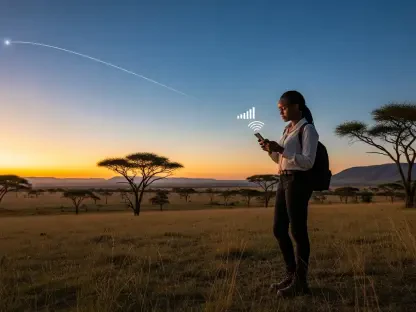What happens when a vital lifeline for internet access in rural America hangs in the balance? Millions of people in remote communities, from the rolling plains of Montana to the deserts of New Mexico, rely on fixed wireless access for their connection to the digital world, and yet a federal mandate threatens to auction off the Citizens Broadband Radio Service (CBRS) spectrum, a critical tool for delivering broadband to these underserved areas. The Wireless Internet Service Providers Association (WISPA) has stepped into the fray, urging the Federal Communications Commission (FCC) to safeguard this resource. This is more than a policy debate—it’s a fight for equity in connectivity.
Why CBRS Matters in the Digital Divide Battle
The significance of CBRS cannot be overstated in the ongoing effort to close the digital divide. Operating in the 3550-3700 MHz range, this spectrum serves as a cost-effective solution for fixed wireless providers to reach areas where laying fiber is impractical or prohibitively expensive. With rural broadband access still lagging—over 20% of rural households lack reliable internet—CBRS stands as a beacon of hope for communities desperate for connection. WISPA’s plea to the FCC underscores a pivotal moment: will policy prioritize immediate revenue from spectrum auctions or the long-term goal of universal access?
The urgency stems from a legislative mandate known as the One Big Beautiful Bill (OBBB), signed into law earlier this year. This bill compels the FCC to auction 800 MHz of spectrum within two years, placing CBRS directly in the crosshairs. As rural areas depend heavily on this technology, the potential loss could derail years of progress, leaving countless families, students, and businesses stranded in a digital desert.
CBRS as the Cornerstone of Rural Internet Programs
Delving deeper into the role of CBRS, its integration with the Broadband Equity Access and Deployment (BEAD) program reveals its indispensable value. BEAD, a federal initiative to expand broadband, leans on fixed wireless solutions powered by CBRS to reach remote locations. Data shows that fixed wireless accounts for 11% of provisionally approved BEAD awards nationwide, with states like Montana and Nebraska relying on it for over 50% of their targeted locations.
The spectrum’s affordability allows smaller providers to compete in regions often ignored by larger telecom companies. Without CBRS, the financial burden of alternative solutions could cripple these providers, stalling BEAD’s momentum. The clash between legislative deadlines and connectivity goals highlights a critical tension in spectrum policy, one that could shape the future of internet access for millions.
Auction Risks: A Blow to Rural Progress
If CBRS, particularly the upper 50 MHz reserved for General Authorized Access (GAA), is auctioned off, the consequences could be devastating. WISPA warns that such a move would disrupt existing users and dismantle investments made by providers who have built networks on this spectrum. In states like Iowa and New Mexico, where over 40% of BEAD locations depend on fixed wireless, the ripple effects would be immediate and severe.
Beyond current disruptions, the auction could stifle innovation in rural broadband solutions. Smaller providers, often the only option in remote areas, might face increased costs or be forced out of the market entirely. This would leave rural residents with fewer choices, higher prices, and a widened gap in access to essential online services like telehealth and remote education.
Industry and Political Voices Rally for CBRS
The push to protect CBRS extends beyond WISPA, resonating with a broad coalition of stakeholders. Louis Peraertz, Vice President of Policy at WISPA, emphasized in a letter to the FCC on September 30 of this year that reallocating CBRS risks undermining BEAD’s objectives and jeopardizing existing investments. Similarly, WISPA CEO David Zumwalt has highlighted the spectrum’s essential role in rural connectivity since the OBBB’s passage.
Political support adds weight to the argument, with bipartisan voices joining the chorus. Ten Republican Senators, including Steve Daines of Montana, have pressed FCC Chairman Brendan Carr to preserve CBRS, citing its importance for innovation. Democratic FCC Commissioner Anna Gomez has also voiced concern, calling the potential loss of spectrum a “crying shame” for companies that have poured billions into wireless advancements. This rare alignment across party lines signals the gravity of the issue.
Strategies to Shield CBRS from Auction Threats
Addressing this crisis demands actionable solutions, and WISPA has proposed a pragmatic approach. One suggestion is for the FCC to identify alternative spectrum bands for auction, thereby meeting the OBBB’s 800 MHz requirement without touching CBRS or the 6 GHz band used for Wi-Fi. This would minimize disruption while fulfilling legislative obligations.
Stakeholders, including providers and community leaders, are encouraged to engage directly with the FCC by submitting feedback on CBRS’s impact in their regions. Policymakers should also leverage BEAD data, showcasing success stories from states with heavy reliance on fixed wireless. Public campaigns can further elevate the human element, reminding decision-makers that behind every policy choice are real families awaiting access to a connected future.
Reflecting on this pivotal moment, the struggle to protect CBRS unfolded as a defining chapter in the quest for digital equity. The unified stance of WISPA, industry leaders, and policymakers underscored a shared commitment to rural connectivity. Looking ahead, the focus shifted to actionable outcomes—whether through alternative spectrum allocations or exemptions for CBRS, the path forward required balancing legislative mandates with the urgent needs of underserved communities. Continued advocacy and engagement with the FCC emerged as essential steps to ensure that rural America was not left behind in the digital age.









